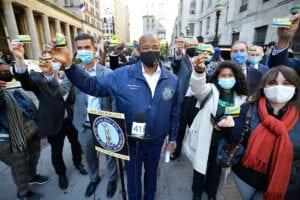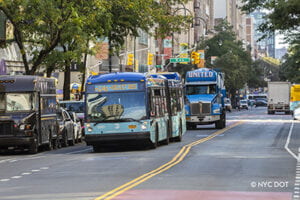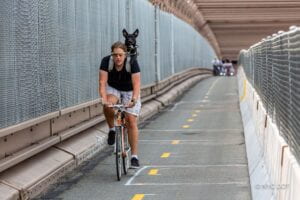by Ben Listman

Eric Adams’ campaign released a number of in-depth plans for New York City, covering topics like the growing NYC’s wind industry, reducing crime, immigrant safety and empowerment, and bolstering the arts. The campaign also released a plan regarding the city’s transportation networks. This plan, titled Moving Forward Together, covers expanding and electrifying the bus system, expanding the cycling network, supporting Open Streets (Open Streets turns streets into spaces prioritizing cyclists and pedestrians), expanding transit accessibility, and addressing the city’s historically racist transit infrastructure. These goals aim to address issues of equity, sustainability, economic growth, and safety. What is missing, however, is the contexts within which these goals exist. Each goal has its own history, obstacles, and costs, which might help residents better understand the city’s progress on these goals so far, how reasonable they are, and what it will take to achieve them. Here, I want to examine Adams’ plans for bus and cycling infrastructure. The city has made great improvements to its cycling and bus infrastructure, building more dedicated space for both in the past decade. Hopefully, Adams’ plans to double down on city efforts will prove fruitful for the city’s equitable transit infrastructure.

Image: 14th Street Busway – MTA
Adams’ plan includes building out and electrifying the city’s bus system. This means making Select Bus Service (SBS) the baseline for bus service and exploring opportunities for true Bus Rapid Transit (BRT), building 150 miles of new bus lanes over four year, expediting the rollout of transit signal priority tech (TSP modifies traffic signal timing in the presence of transit vehicles), and speeding up the city’s conversion to electric buses. SBS uses vehicle segregated, and camera-enforced lanes such as the 14th Street busway in Manhattan. This improves speed and reliability on long and busy corridors, and makes bus travel quicker and more accessible. Currently, SBS in New York City falls short of international best practices for BRT. However, the city has been making constant improvements. The Better Buses Restart, launched in June 2020 as a partnership between the MTA and NYC DOT, has seen over 16 new miles of dedicated bus lanes. These new busways have improved speeds up to 30%. The city continues to expand bus prioritization across the city under this program, and since this goal is vague, and open-ended, any progress achieves the objective. Enhancing existing lanes under the Better Buses plan seems reasonable enough. The plan contains reasonable and detailed goals. However, having only built 16 additional miles of bus lanes in 2020, the largest one-year effort in the city’s history, the city will be hard pressed to keep up with Adams’ commitment to building 150 miles of new bus lanes in four years. This would require more than doubling the Better Buses goal of ten to fifteen miles each year. I would love to find out that 150 miles over four years is in fact a very attainable goal (it certainly seems like it), and the city’s current standard is too low. The next goal of expediting increased TSP is also vague, thus making any improvements achievable and an easy political win. The Better Buses goal was to add 300 TSP intersections each year, which the city already exceeded in 2020, adding over 460 TSP intersections.
For accelerating electric bus adoption across the city, Adams suggests raising money through capital programs (presumably bonds) to pay for high upfront costs in order to reap the long-term benefits of electric buses. These benefits include minimizing environmental harm, and fuel and maintenance cost savings. The MTA has already announced it will increase its electric bus purchase for 2021 from forty five to sixty buses. The MTA’s 2020-2024 capital budget includes $1.1 billion for 500 electric buses and charging infrastructure at bus depots. NYC’s capital budget also has allocations towards MTA bus infrastructure including facilities and equipment, vehicle purchase, refurbishment, and improvements, and supplemental streetscape equipment for SBS. The largest obstacles to electrification include setting up the electric grid for efficient charging, and battery drainage due to cold weather, both of which require careful planning and siting of on-route chargers to ensure constant charge in bus batteries. The city and the MTA do seem to be on the same page when it comes to bus electrification (most of which is the MTA’s responsibility, at least financially), and already exceeding previously set expectations. With a little extra push, accelerated electrification is within reach. Because the bus system is only beginning to electrify with plans to accelerate in the near future, with a little input from his administration, Adams will be there when it happens.

Image: Brooklyn Bridge Bike Path – Curbed
Next, from the bus to bikes, Adams wants to expand the city’s cycling network. Unlike his bus plans, the cycling plan is more detailed. He aims to build 300 new miles of protected bike lanes in four years with a projected cost of $45 million each year. Ideally this money will come from federal DOT funding. The plan includes creating “bicycle superhighways” using space under elevated highways and railways. The plan also aims to expand secure bike parking. 2020 saw just over 29 new miles of protected bike lanes installed, when de Blasio aimed to build over 30 miles during 2021. As long as the extra $45 million a year comes from federal dollars, funding bike lane expansion should not be a problem. Ensuring bike lanes are actually protected, however, has not been the city’s strong suit. Hopefully, the city will start to use more concrete barriers in newer protected lanes, as opposed to the flexible or painted barriers that leave cyclists vulnerable to obstruction and collisions. Siting “bicycle superhighways” under elevated highways and railways is a creative use of underutilized space, and increasing capacity is needed to allow for more greater ridership. However, creating an arterial network of protected, continuous, high capacity lanes that efficiently connects the entire city cannot rely solely on the routes of already existing infrastructure. They will have to connect safely with routes through central areas as well. Secure bike parking has become increasingly important as theft rose 27% along with the city’s increase in ridership during the pandemic. When it comes to secure bike parking, the word “expansion” is an understatement. All city-built bike parking is vulnerable to theft and weather. The majority of secure bike parking is only available in private buildings for employees, students, building residents, and garage customers. Oonee, a New York City startup, has been working with different property owners around the city to implement secure bike parking pods free to the public. They continue to implement new pods, partnering with Jersey City, and private developers in Brooklyn and Queens. They have even announced a pilot with the MTA. Aside from supporting private implementation of public secure parking, the Adams administration can look to city-provided spaces like that of the Massachusetts Bay Transit Authority (MBTA) attached to transit centers, or London’s cycle hangars that occupy on street parking spaces. A comprehensive cycling network is central to New York City’s future as a sustainable city. Along with a network of protected lanes, cyclists will depend on secure spaces to put their bicycles when they go into stores, use parks, go to work, use transit, or park bikes overnight. The Adams administration must think seriously and boldly if it wants to begin to approach global standards for cycling friendly cities.
Adams cites the economy, public safety, equity, and environmental sustainability as issues that can be addressed through transportation improvements. While his plans for transit can help improve upon these issues, Adams’ campaign has left room for ambiguity and open endedness. Knowing where these plans fit into the city’s current state of bus and cycling infrastructure can lead to a clearer understanding of how to move forward. In the end, Adams’ administration will have to fill us in. It has, in fact, been characteristic of Adams and his campaign to leave things open-ended and swap narratives. The goals outlined in this transit plan vary in size, but they all require decisive action to increase efforts. We will hopefully know more as strategies unfold in January.
Cover Image Source – The New York Post